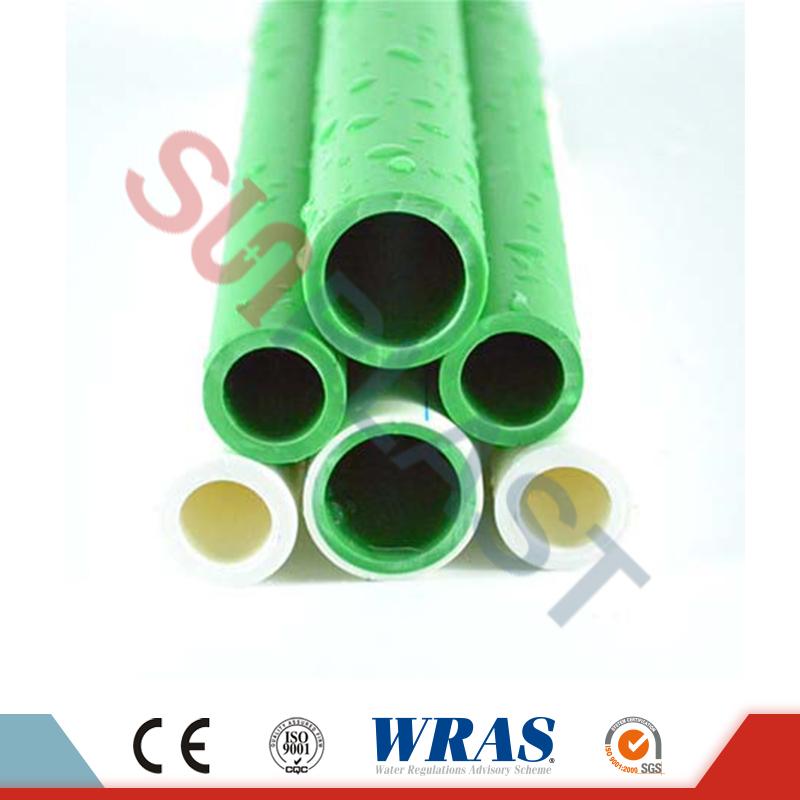
- English
- Español
- Português
- русский
- Français
- 日本語
- Deutsch
- tiếng Việt
- Italiano
- Nederlands
- ภาษาไทย
- Polski
- 한국어
- Svenska
- magyar
- Malay
- বাংলা ভাষার
- Dansk
- Suomi
- हिन्दी
- Pilipino
- Türkçe
- Gaeilge
- العربية
- Indonesia
- Norsk
- تمل
- český
- ελληνικά
- український
- Javanese
- فارسی
- தமிழ்
- తెలుగు
- नेपाली
- Burmese
- български
- ລາວ
- Latine
- Қазақша
- Euskal
- Azərbaycan
- Slovenský jazyk
- Македонски
- Lietuvos
- Eesti Keel
- Română
- Slovenski
- मराठी
- Srpski језик
Do you choose PPR water pipe or PE pipe for home improvement water supply pipe?
2023-03-18
Both PE pipes and PPR pipes are two materials of pipes, and both can be used for water supply, so why do home improvement water supply pipes basically choose PPR water pipes, while PE pipes are mostly used in municipal pipes, and rarely used in home decoration water supply pipes. The reasons are as follows:
First, the modulus of elasticity affects the stiffness and flexibility of the pipeline
The material of PPR pipes is polypropylene, the modulus of elasticity is 850MPa, the rigidity is good, but the flexibility is not enough; the material of PE water pipe is medium density polyethylene, the modulus of elasticity is only about 550MPa, the flexibility is good, but the rigidity is not enough; PE water pipe is used for building water supply In the field, the straightness of the pipeline is not good, it is easy to bend and deform, and the pipeline is not beautiful. However, in the field of municipal water supply, due to the relatively more complex environment, pipes need to have good flexibility to resist impact, so PE pipes are more suitable for the field of municipal water supply. Compared with PPR water pipes, due to their good rigidity, poor flexibility, and low-temperature brittleness, they are more suitable for the field of building water supply.
Second, heat resistance affects the safe operation of pipelines
Although PE pipe has good low temperature performance, its high temperature performance is not as good as PPR water pipe. The field of building water supply, especially home decoration, requires the use of hot water pipes. However, according to data, the heat-resistant temperature of conventional PE pipes is 60°C, and the conventional temperature of household water supply is about 50°C. Running, the aging speed of PE pipes will be greatly accelerated, not to mention that the dominant temperature will far exceed 50 ° C, so PE pipes are not suitable for hot water transportation, which is one of the reasons why they are generally not used for home decoration.
Third, thermal conductivity, which affects the insulation performance of pipelines
The thermal conductivity of the PPR water pipe is 0.24, and the thermal conductivity of the PE water pipe is 0.42, which is nearly twice as high. We know that the lower the thermal conductivity, the better the thermal insulation performance of the water pipe. If PE pipes are used in floor heating, this will give full play to its advantages. Good heat dissipation means that the heat radiation effect is also better, but it becomes its disadvantage when used in hot water pipes. Good heat dissipation means large heat loss. The surface temperature of the pipe is also higher, and it is easy to burn hands. As a water supply for home improvement, it is obvious that PE pipes are not as reasonable as PPR pipes.
Fourth, welding performance affects the difficulty of pipeline construction
In terms of welding performance, the flanging of PPR water pipe is round, while the flanging of PE water pipe is irregular and easy to block; in addition, the welding temperature of PE pipe and PPR pipe is different, PPR water pipe is 260 ℃, PE water pipe is 230 ℃, using the market The special welding machine for PPR water pipes on the market often causes over-welding, resulting in water leakage. Moreover, because the PE material is easy to oxidize, special tools must be used to scrape off the oxide skin on the surface before welding, otherwise a truly integrated pipeline cannot be formed, and the pipeline is prone to water leakage.
First, the modulus of elasticity affects the stiffness and flexibility of the pipeline
The material of PPR pipes is polypropylene, the modulus of elasticity is 850MPa, the rigidity is good, but the flexibility is not enough; the material of PE water pipe is medium density polyethylene, the modulus of elasticity is only about 550MPa, the flexibility is good, but the rigidity is not enough; PE water pipe is used for building water supply In the field, the straightness of the pipeline is not good, it is easy to bend and deform, and the pipeline is not beautiful. However, in the field of municipal water supply, due to the relatively more complex environment, pipes need to have good flexibility to resist impact, so PE pipes are more suitable for the field of municipal water supply. Compared with PPR water pipes, due to their good rigidity, poor flexibility, and low-temperature brittleness, they are more suitable for the field of building water supply.
Second, heat resistance affects the safe operation of pipelines
Although PE pipe has good low temperature performance, its high temperature performance is not as good as PPR water pipe. The field of building water supply, especially home decoration, requires the use of hot water pipes. However, according to data, the heat-resistant temperature of conventional PE pipes is 60°C, and the conventional temperature of household water supply is about 50°C. Running, the aging speed of PE pipes will be greatly accelerated, not to mention that the dominant temperature will far exceed 50 ° C, so PE pipes are not suitable for hot water transportation, which is one of the reasons why they are generally not used for home decoration.
Third, thermal conductivity, which affects the insulation performance of pipelines
The thermal conductivity of the PPR water pipe is 0.24, and the thermal conductivity of the PE water pipe is 0.42, which is nearly twice as high. We know that the lower the thermal conductivity, the better the thermal insulation performance of the water pipe. If PE pipes are used in floor heating, this will give full play to its advantages. Good heat dissipation means that the heat radiation effect is also better, but it becomes its disadvantage when used in hot water pipes. Good heat dissipation means large heat loss. The surface temperature of the pipe is also higher, and it is easy to burn hands. As a water supply for home improvement, it is obvious that PE pipes are not as reasonable as PPR pipes.
Fourth, welding performance affects the difficulty of pipeline construction
In terms of welding performance, the flanging of PPR water pipe is round, while the flanging of PE water pipe is irregular and easy to block; in addition, the welding temperature of PE pipe and PPR pipe is different, PPR water pipe is 260 ℃, PE water pipe is 230 ℃, using the market The special welding machine for PPR water pipes on the market often causes over-welding, resulting in water leakage. Moreover, because the PE material is easy to oxidize, special tools must be used to scrape off the oxide skin on the surface before welding, otherwise a truly integrated pipeline cannot be formed, and the pipeline is prone to water leakage.
It can be seen that although PPR pipes and PE water pipes can be hot-melt welded, they are not at the same level in terms of standardized operation difficulty. PPR water pipes are easier to operate and more convenient to construct. A very critical reason for the tube.





